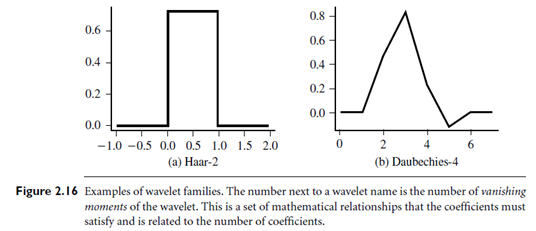Dimensionality Reduction
Introduction: In dimensionality reduction, data encoding or transformations are applied so as to obtain a reduced or “compressed” representation of the original data. If the original data can be reconstructed from the compressed data without any loss of information, the data reduction is called lossless. If, instead, we can reconstruct only an approximation of the original data, then the data reduction is called lossy. There are several well-tuned algorithms for string compression. Although they are typically lossless, they allow only limited manipulation of the data. In this section, we instead focus on two popular and effective methods of lossy dimensionality reduction: wavelet transforms and principal components analysis.

Wavelet Transforms: The discrete wavelet transform (DWT) is a linear signal processing technique that, when applied to a data vector X, transforms it to a numerically different vector, X0, of wavelet coefficients. The two vectors are of the same length. When applying this technique to data reduction, we consider each tuple as an n-dimensional data vector, that is, X = (x1;x2; : : : ;xn), depicting n measurements made on the tuple from database attributes.8
The usefulness lies in the fact that the wavelet transformed data can be truncated. A compressed approximation of the data can be retained by storing only a small fraction of the strongest of the wavelet coefficients. For example, all wavelet coefficients larger than some user-specified threshold can be retained. All other coefficients are set to 0. The resulting data representation is therefore very sparse, so that operations that can take advantage of data sparsity are computationally very fast if performed in wavelet space. The technique also works to remove noise without smoothing out the main features of the data, making it effective for data cleaning as well. Given a set of coefficients, an approximation of the original data can be constructed by applying the inverse of the DWT used.
The DWT is closely related to the discrete Fourier transform (DFT), a signal processing technique involving sines and cosines. In general, however, theDWT achieves better lossy compression. That is, if the same number of coefficients is retained for aDWT and a DFT of a given data vector, the DWT version will provide a more accurate approximation of the original data. Hence, for an equivalent approximation, the DWT requires less space than the DFT. Unlike the DFT, wavelets are quite localized in space, contributing to the conservation of local detail.
There is only one DFT, yet there are several families of DWTs. Figure 2.16 shows some wavelet families. Popular wavelet transforms include the Haar-2, Daubechies-4, and Daubechies-6 transforms. The general procedure for applying a discrete wavelet transform uses a hierarchical pyramid algorithm that halves the data at each iteration, resulting in fast computational speed. The method is as follows:
1. The length, L, of the input data vector must be an integer power of 2. This condition can be met by padding the data vector with zeros as necessary (L ≥ n).
2. Each transform involves applying two functions. The first applies some data smoothing, such as a sum or weighted average. The second performs a weighted difference, which acts to bring out the detailed features of the data.
3. The two functions are applied to pairs of data points in X, that is, to all pairs of measurements (x2i ;x2i 1). This results in two sets of data of length L=2. In general, these represent a smoothed or low-frequency version of the input data and the high frequency content of it, respectively.
4. The two functions are recursively applied to the sets of data obtained in the previous loop, until the resulting data sets obtained are of length 2.
5. Selected values from the data sets obtained in the above iterations are designated the wavelet coefficients of the transformed data.